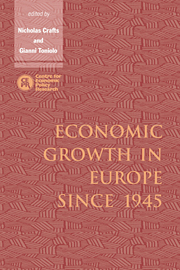Book contents
- Frontmatter
- Contents
- List of figures
- List of tables
- Preface
- List of contributors
- 1 Postwar growth: an overview
- 2 Institutions and economic growth: Europe after World War II
- 3 The varieties of Eurosclerosis: the rise and decline of nations since 1982
- 4 Why the 1950s and not the 1920s? Olsonian and non-Olsonian interpretations of two decades of German economic history
- 5 Convergence, competitiveness and the exchange rate
- 6 British economic growth since 1945: relative economic decline … and renaissance?
- 7 Economic growth in postwar Belgium
- 8 France, 1945–92
- 9 Economic growth and the Swedish model
- 10 Characteristics of economic growth in the Netherlands during the postwar period
- 11 Portuguese postwar growth: a global approach
- 12 Growth and macroeconomic performance in Spain, 1939–93
- 13 Irish economic growth, 1945–88
- 14 Italy
- 15 West German growth and institutions, 1945–90
- 16 An exercise in futility: East German economic growth and decline, 1945–89
- 17 Postwar growth of the Danish economy
- 18 Reflections on the country studies
- Index
5 - Convergence, competitiveness and the exchange rate
Published online by Cambridge University Press: 04 August 2010
- Frontmatter
- Contents
- List of figures
- List of tables
- Preface
- List of contributors
- 1 Postwar growth: an overview
- 2 Institutions and economic growth: Europe after World War II
- 3 The varieties of Eurosclerosis: the rise and decline of nations since 1982
- 4 Why the 1950s and not the 1920s? Olsonian and non-Olsonian interpretations of two decades of German economic history
- 5 Convergence, competitiveness and the exchange rate
- 6 British economic growth since 1945: relative economic decline … and renaissance?
- 7 Economic growth in postwar Belgium
- 8 France, 1945–92
- 9 Economic growth and the Swedish model
- 10 Characteristics of economic growth in the Netherlands during the postwar period
- 11 Portuguese postwar growth: a global approach
- 12 Growth and macroeconomic performance in Spain, 1939–93
- 13 Irish economic growth, 1945–88
- 14 Italy
- 15 West German growth and institutions, 1945–90
- 16 An exercise in futility: East German economic growth and decline, 1945–89
- 17 Postwar growth of the Danish economy
- 18 Reflections on the country studies
- Index
Summary
Introduction
Recent years have seen a burgeoning literature on the issue of why countries’ per-capita income levels converge (or do not, as the case may be). This topic is hardly new, of course, and much of the present research is merely rediscovering arguments that had long been known (the advantages of relative backwardness, the role of skills, the importance of investment or of learning by doing, etc.). There is, however, one feature of the older literature which recent writings have hardly exploited: that is, the role which government intervention (through, for instance, macroeconomic, industrial or exchange rate policies) could play in promoting growth. This neglect is understandable. In the context of the dominating orthodoxy, industrial policies can only lead to inferior outcomes, while macroeconomic and exchange rate policies, when not instantly ineffective, must be so in the medium term. Similarly heretic, and hence ignored, are approaches of the ‘export-led growth’ variety which dare to suggest that demand factors may contribute to longer-run growth differences.
Yet, just a cursory look at the economic history of the OECD countries since World War II suggests that the role of demand and policies cannot be ignored, notably in the 1950s (witness the importance that many attribute to the indicative planning of France, to the investment subsidies of Germany, to the industrial policies of Japan, and so on). In particular, policies may have influenced one area that seems crucial for an understanding of the convergence process, that of international competitiveness. Traditional approaches usually view the latter as an entirely endogenous function of the growth process itself.
- Type
- Chapter
- Information
- Economic Growth in Europe since 1945 , pp. 107 - 130Publisher: Cambridge University PressPrint publication year: 1996
- 36
- Cited by



